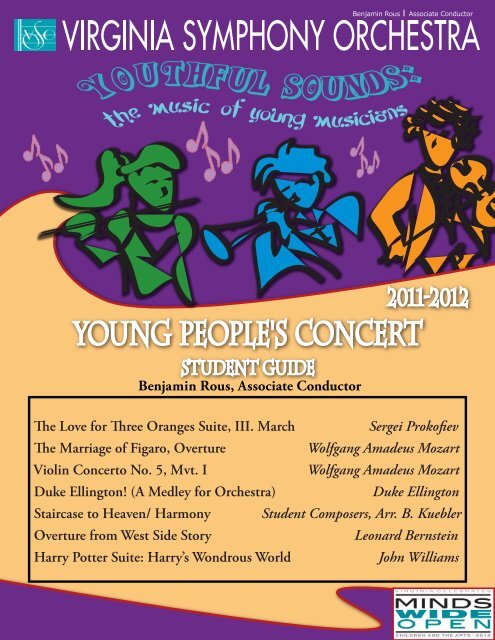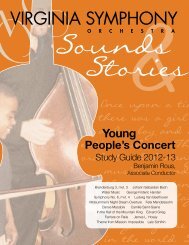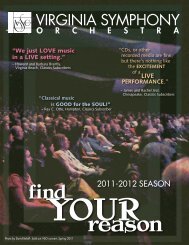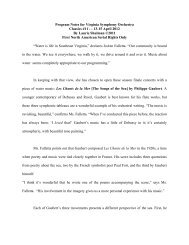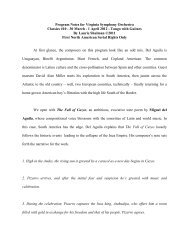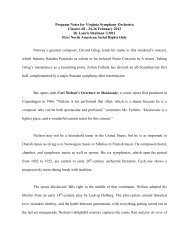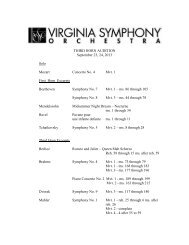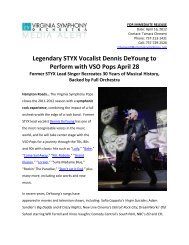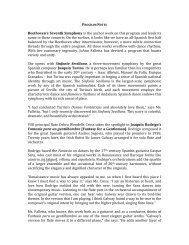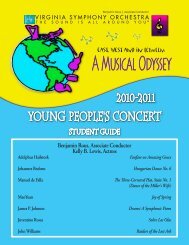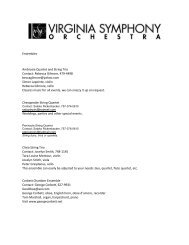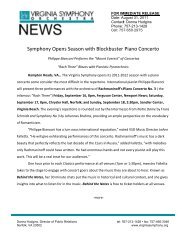outhful Young People's Concert - Virginia Symphony Orchestra
outhful Young People's Concert - Virginia Symphony Orchestra
outhful Young People's Concert - Virginia Symphony Orchestra
You also want an ePaper? Increase the reach of your titles
YUMPU automatically turns print PDFs into web optimized ePapers that Google loves.
Benjamin Rous<br />
Associate Conductor<br />
Y<strong>outhful</strong> Sounds:<br />
The<br />
Music<br />
of <strong>Young</strong> Musicians<br />
<strong>Young</strong> <strong>People's</strong> <strong>Concert</strong><br />
Student Guide<br />
Benjamin Rous, Associate Conductor<br />
2011-2012<br />
The Love for Three Oranges Suite, III. March<br />
Sergei Prokofiev<br />
The Marriage of Figaro, Overture<br />
Wolfgang Amadeus Mozart<br />
Violin <strong>Concert</strong>o No. 5, Mvt. I<br />
Wolfgang Amadeus Mozart<br />
Duke Ellington! (A Medley for <strong>Orchestra</strong>)<br />
Duke Ellington<br />
Staircase to Heaven/ Harmony Student Composers, Arr. B. Kuebler<br />
Overture from West Side Story<br />
Leonard Bernstein<br />
Harry Potter Suite: Harry’s Wondrous World<br />
John Williams
<strong>Concert</strong> Guide Table of Contents<br />
PAGE<br />
<strong>Young</strong> <strong>People's</strong> <strong>Concert</strong><br />
3 Welcome and Introduction<br />
4 Interview with Associate Director Benjamin Rous<br />
5 Biographies of Guest Soloists<br />
7 Roster of <strong>Virginia</strong> <strong>Symphony</strong> <strong>Orchestra</strong> Musicians<br />
8 Preparing for Your Trip<br />
9 Composers’ Biographies<br />
16 Study Guide Activities<br />
27 Vocabulary Page<br />
28 Partners in Education<br />
29 Teacher Evaluation
Welcome and Introduction<br />
Dear Teacher,<br />
Come join the musicians of the <strong>Virginia</strong> <strong>Symphony</strong> <strong>Orchestra</strong> as they play music composed or<br />
inspired by the energy of youth! From Mozart to Bernstein, from Prokofiev to Ellington, experience the<br />
power and creativity of musicians who began composing at an early age- music that continues to touch the<br />
hearts of today’s young and young at heart. These performances will also feature young musicians from the<br />
Hampton Roads area playing along with the <strong>Virginia</strong> <strong>Symphony</strong> <strong>Orchestra</strong> as part of the “y<strong>outhful</strong> sounds”<br />
that will be heard at each concert. As students experience the sights and sounds of a symphony orchestra<br />
LIVE, they will also explore answers to questions such as:<br />
What basic musical elements are used in composition Why is Mozart’s music still played<br />
today How does jazz sound different from classical music Can they (your students) compose music<br />
too<br />
This exciting symphonic experience, designed especially for 3rd – 5th graders (but also<br />
appropriate for younger and older students), features the performance of music that illustrates how<br />
energy, imagination and education - all the components your students possess - can culminate in<br />
memorable artistic endeavors. Our <strong>Young</strong> People’s <strong>Concert</strong>s, coupled with the content of this guide<br />
– specifically written for student use – will guarantee a quality educational experience your students<br />
won’t soon forget. So come with us and enjoy our “Y<strong>outhful</strong> Sounds.” See where music will take you!<br />
Marsha Staples<br />
Director of Education and Community Engagement<br />
<strong>Virginia</strong> <strong>Symphony</strong> <strong>Orchestra</strong><br />
861 Glenrock Rd. Suite 200<br />
Norfolk, VA 23502<br />
mstaples@virginiasymphony.org<br />
Carrie Green<br />
Education Manager<br />
<strong>Virginia</strong> <strong>Symphony</strong> <strong>Orchestra</strong><br />
861 Glenrock Rd. Suite 200<br />
Norfolk, VA 23502<br />
cgreen@virginiasymphony.org
Associate Conductor: Benjamin Rous<br />
Meet our conductor for this season’s <strong>Young</strong> People’s <strong>Concert</strong>s: Maestro Benjamin Rous. He’s looking<br />
forward to seeing you there and hopes that you will enjoy your experience! We asked him a few questions so<br />
that you could get to know him a bit before coming to the concert, and<br />
here is what he had to say:<br />
What is your favorite color<br />
The blue of a blue sky on a summer day is my favorite.<br />
What is your favorite food<br />
It’s apple pie the way my mom makes it.<br />
Do you have any pets<br />
Yes. Jack is the best cat in the world. He is white, but he has two dark<br />
patches on his forehead and a dark tail. It really looks like his tail belongs<br />
to another cat. He’s very funny-looking; but he’s the most loving cat, and<br />
he’s friendly with strangers as well.<br />
Are there any sports you enjoy playing or watching<br />
I played hockey for eight years growing up, and I was the setter on my high school volleyball team.<br />
Recently, I’ve gotten back into Ping Pong, as well. But I love watching any sports.<br />
What are your favorite pastimes or hobbies<br />
Whale watching, walks in the country, chess.<br />
What were your favorite books when you were a kid<br />
I read The Phantom Tollbooth every year from fourth through eighth grade. Also, anything by Roald Dahl.<br />
Do you have any hidden talents no one knows about<br />
Skipping stones over the water, I’m the best I’ve ever met.<br />
When did you first discover your love of music<br />
Before I remember what music sounded like, I remember the desire to take violin lessons. I was six.<br />
What instrument(s) do you play Are there any instruments you wish you could play and why<br />
Violin, viola and piano. I wish I could play piano a lot better than I do. It would just be so useful to be a<br />
virtuoso pianist.<br />
What/ who inspired you towards the podium Was everyone supportive of your decision<br />
My youth orchestra conductors were my main inspirations. Yes, luckily, I’ve been encouraged by all the<br />
important people in my life.<br />
What do you love most about conducting<br />
I love that it’s my job to focus on how all the parts go together and how the whole thing should affect the<br />
listener.
Guest Soloists<br />
Brendon Elliott<br />
Brendon is 17 years old and attends Menchville High School in Newport News, VA where he studies<br />
very hard and is in his school’s Scholars Program. This year, he will be in the 12th grade. Along with getting<br />
great grades at school, he studies the violin with the <strong>Virginia</strong> <strong>Symphony</strong><br />
<strong>Orchestra</strong>’s <strong>Concert</strong>master, Vahn Armstrong, and plays in a quartet (a group<br />
of four musicians) with his mom, younger brother and sister- the Elliott<br />
Family String Quartet. He began his violin studies at the age of three, and<br />
quickly made everyone aware of his exceptional musical gifts. At the age of<br />
six, he was accepted into his first youth orchestra where he was the<br />
youngest of all the members! Now at 17, he has been playing with the<br />
Peninsula Youth <strong>Orchestra</strong> for the past ten years. Brendon has been its<br />
concert master (the first-chair violin player) for six years now.<br />
He made his debut as a soloist when he was ten years old. Since<br />
then, he has performed in and won numerous competitions, appeared on the<br />
famous radio show “From the Top” and performed as the featured soloist for<br />
many orchestras. The Richmond <strong>Symphony</strong> <strong>Orchestra</strong> and the Richmond<br />
Philharmonic <strong>Orchestra</strong> - and now the <strong>Virginia</strong> <strong>Symphony</strong> <strong>Orchestra</strong>, as<br />
well - are a few. When Brendon is not practicing or performing on his<br />
violin, he likes to play basketball, Wii games and reading. His favorite color is purple, and he loves mac ‘n<br />
cheese and pizza.<br />
Annika Jenkins<br />
Annika attends Laurel Springs Academy of the Gifted & Talented where she is an honor student. She is<br />
also an all honors scholarship student at The Julliard School,<br />
Pre-College Division, in New York City! By invitation, audition<br />
and as first prize winner in numerous competitions, Annika has<br />
been a featured guest soloist in dozens of concerts with nearly<br />
twenty professional and community orchestras and ensembles.<br />
She made her orchestral debut at eleven and has been<br />
performing steadily since then. She has even been featured on<br />
the famous radio show, “From the Top.” A fantastically talented<br />
violinist, she also plays the piano!<br />
Along with her many, many honors and awards as a musician,<br />
Annika is also a young philanthropist (someone who gives of her<br />
time and resources towards helping others) - often donating her<br />
award money towards other causes and being active as a Girl Scout. Her contributions have caught the<br />
attention of many people, including <strong>Virginia</strong> Beach’s former mayor, Meyera E. Oberndorf. She even presented<br />
Annika with a Key to the City of <strong>Virginia</strong> Beach!<br />
When she is not practicing, performing or composing, Annika loves to read, sketch, play guitar and<br />
hang out with her sisters and friends. She also loves animals, playing with her pet dog (a Siberian Husky<br />
named Zorro) and two cats (Misty and Wink).
Guest Soloists<br />
Sean Heely<br />
Sean recently graduated from Deep Creek High School, where he served as <strong>Orchestra</strong> Class President and<br />
<strong>Concert</strong>master. Along with performing with his high school’s orchestra, he also performed with the Deep Creek<br />
Chamber Quartet Ensemble and the Flowing Tide Ceilidh (Pronounced KAY-lee) Band.<br />
The past four years have been busy for Sean. Along with composing,<br />
he auditioned and was accepted into the Chesapeake All-City Honors<br />
<strong>Symphony</strong> <strong>Orchestra</strong> and Southeastern District Senior Regionals <strong>Orchestra</strong><br />
every single year. This past year, he auditioned and was accepted into the<br />
All-<strong>Virginia</strong> All-State <strong>Symphony</strong> <strong>Orchestra</strong>. Sean thanks Vahn Armstrong for<br />
this accomplishment. Mr. Armstrong, the <strong>Concert</strong>master for the <strong>Virginia</strong><br />
<strong>Symphony</strong> <strong>Orchestra</strong>, gave Sean private lessons throughout this past yearfor<br />
which Sean is very grateful.<br />
It seems that Sean was destined for music. He comes from a<br />
family where almost every single person plays a musical instrument! When he<br />
was little, he used to listen to tunes from the radio or elsewhere and then play<br />
them on his grandmother’s piano. He began playing the violin at 10. His older<br />
and much loved sister, Karen, was his main influence in choosing to study the<br />
violin. Sean will now be attending George Mason University where he will be studying musical performance and<br />
conducting.<br />
Hannah Whitlock<br />
Annika, now 16 years old, was a student at Bethel Christian School in Hampton, VA - having finished<br />
her sophomore year there. Currently, she is homeschooling so that she can<br />
devote more of her time towards studying music. Hannah began playing the<br />
violin right before her fifth birthday and has had a busy and successful time<br />
since then.<br />
At the age of 12, she was awarded a full merit scholarship to attend the<br />
prestigious Interlochen Arts Camp. She has auditioned for and been accepted<br />
into many performing ensembles, serving as the concertmaster of the Bay<br />
Youth <strong>Concert</strong> <strong>Orchestra</strong> and Principal Second Violin of the Bay Youth<br />
<strong>Symphony</strong> <strong>Orchestra</strong>. Now, she is a member of its 1st violin section. She was<br />
the only 9th grade violinist chosen for the 1st violin section of the Southeast<br />
Region Senior Regional <strong>Orchestra</strong> in 2009, she and won the Assistant<br />
<strong>Concert</strong>master position of the Southeast Region Senior Regional <strong>Orchestra</strong> in<br />
2010.<br />
Along with competing in and winning numerous competitions, she is also<br />
part of a chamber group at Bethel Christian School. Hannah also enjoys<br />
performing in her church’s orchestra and regularly playing with her family, as well.<br />
Note This!<br />
For more biographical information about each guest soloist, please visit our website at<br />
www.<strong>Virginia</strong><strong>Symphony</strong>.org. Go to the <strong>Young</strong> People’s <strong>Concert</strong> page in the Education & Community<br />
<br />
Engagement section.
<strong>Virginia</strong> <strong>Symphony</strong> <strong>Orchestra</strong> Roster<br />
VIOLIN<br />
Vahn Armstrong, <strong>Concert</strong>master<br />
Yun Zhang, Associate <strong>Concert</strong>master<br />
Amanda Gates Armstrong, Assistant <strong>Concert</strong>master<br />
Simon Lapointe, Principal Second<br />
Elizabeth Coulter Vonderheide, Assistant Principal Second<br />
Christine Allison<br />
Jorge Aguirre<br />
Lesa McCoy Bishop<br />
Wesi Chong Boyer<br />
Mayu Cipriano<br />
Lillian Curry<br />
Amy Taira Danielson<br />
Jeanne DeDominick<br />
Linda Dennis<br />
Lisbeth Dreier +<br />
Bill Fearnside<br />
Kirsty B. Green<br />
Joan Griffing<br />
Allegra Tortolano Havens<br />
Linda Hurwitz<br />
Pavel Ilyashov<br />
Reina Inui<br />
Tara-Louise Montour<br />
Christina Morton<br />
Seiko Syvertsen<br />
VIOLA<br />
Beverly Kane Baker, Principal<br />
Amy Davis<br />
Xuan Lin<br />
Anastasia Migliozzi<br />
Satoko Rickenbacker<br />
Jocelyn Smith<br />
Matthew Umlauf<br />
CELLO<br />
Michael Daniels, Principal<br />
Rebecca Gilmore, Acting Assistant Principal<br />
Lui Berz<br />
Susan Hines<br />
Nancy Keevan<br />
J. Carter Melin<br />
JoAnn Falletta, Music Director<br />
Benjamin Rous, Associate Conductor<br />
Robert Shoup, Chorus Master/ Staff Conductor<br />
Akiko Fujimoto, Conducting Associate<br />
PICCOLO<br />
To Be Determined<br />
OBOE<br />
Sherie Lake Aguirre, Principal<br />
George Corbett<br />
Michael Dressler<br />
ENGLISH HORN<br />
George Corbett<br />
CLARINET<br />
Patti Ferrell Carlson, Principal +<br />
Scott Boyer<br />
E-FLAT CLARINET<br />
Scott Boyer<br />
BASS CLARINET<br />
William Thomas<br />
BASSOON<br />
Laura Leisring, Principal<br />
David Savige<br />
CONTRABASSOON<br />
Hana Lee +<br />
HORN<br />
David Wick, Principal<br />
Hazel Dean Davis<br />
Wilford Holcombe<br />
Kimberly Gilman<br />
Dennis Herring<br />
TRUMPET<br />
David Vonderheide, Principal<br />
Stephen Carlson, Associate Principal<br />
Ryan Barwise<br />
TROMBONE<br />
R. Scott McElroy, Principal<br />
Donna Parkes<br />
BASS<br />
Scott Harris, Principal<br />
Christopher White, Assistant Principal<br />
Thomas P. Reel<br />
Jeremy Barth<br />
Frederick Dole<br />
Jason Phillips<br />
HARP<br />
Barbara Chapman, Principal<br />
FLUTE<br />
Debra Wendells Cross, Principal<br />
Joanne Meyer White<br />
BASS TROMBONE<br />
Rodney Martell<br />
TUBA<br />
Peter DuBeau, Principal<br />
TIMPANI<br />
John Lindberg, Principal<br />
PERCUSSION<br />
Robert W. Cross, Principal<br />
Tim Bishop<br />
J. Scott Jackson<br />
+ Denotes Leave of Absence
Preparing for Your Trip:<br />
Proper <strong>Concert</strong> Etiquette-<br />
Don’t Leave Home Without It!<br />
<strong>Young</strong> <strong>People's</strong> <strong>Concert</strong><br />
<br />
What is Etiquette<br />
It’s a set of rules for the way we act. For example, when you chew with your<br />
mouth closed at lunch, you are displaying proper dining etiquette. Or when you walk<br />
down the hallway quietly in line as a class, you are displaying proper hallway etiquette.<br />
But etiquette is more than just a set of rules or using good manners, it’s about<br />
making the people around you feel comfortable. After all, chewing food with your<br />
mouth wide open probably doesn’t look too nice to your fellow classmates and might<br />
be kind of gross. In the concert hall, just like in the lunch room and in your school’s<br />
hallways, there is a set of rules for the way the audience should act. This is called<br />
proper concert etiquette.<br />
Here is a list of things to remember for your trip to the concert hall. If you put the<br />
words to a melody or use them in a rap, you’ll never forget them!<br />
Music SOL Connection:<br />
3.1(1)(3), 3.14<br />
4.1(1), 4.7, 4.14<br />
5.1(1)(3), 5.6(1), 5.12<br />
Don’t forget your concert etiquette:<br />
It’s about listening with due respect.<br />
Please don’t talk or whisper, tap or sing<br />
Unless the maestro asks for that very thing.<br />
Don’t eat or drink while musicians play.<br />
Keep your gum and candy far away.<br />
Turn off alarms on electronic things,<br />
Like cell phones and watches, so they won’t ring.<br />
Don’t bring toys to play with or jingly blings.<br />
They might distract the woodwinds, or even the strings.<br />
Sighing, crying, sleeping too…<br />
The percussion section might stop to stare at you.<br />
And should you clap when the music stops<br />
Yes. But only when the conductor’s hands drop.<br />
When it’s time to clap, he’ll turn around,<br />
Ready for all of the applause to sound.<br />
And most of all, keep an open mind<br />
To remember the sights and sounds you’ll find.
Composer: Sergei Prokofiev<br />
What you’ll hear at the concert:<br />
Love for Three Oranges Suite, III. March<br />
Born in Sontsovka, Ukraine<br />
(1891-1953)<br />
Sergei Prokofiev started composing by the age of five. Because he didn’t know how to write<br />
properly at that young age, his mother helped him write out his first piano<br />
piece called “Indian Gallop.” She was the one who first taught him how to<br />
play the piano and encouraged his musical talents throughout his<br />
childhood. The rest of his family also supported his love for music as a<br />
child, and he enjoyed playing his piano for them. He even wrote an opera<br />
for his family to perform... at the age of nine! It was called “The Giant.”<br />
An opera is like a play set to music. The actors sing their lines, and songs<br />
are sung throughout.<br />
At 13, Prokofiev became the youngest student to be accepted at<br />
the St. Petersburg Conservatory- the greatest music conservatory<br />
(a school especially for the study of music) in Russia. He had a habit of<br />
being very self confident, frustrating and shocking his teachers with his<br />
music so much that he earned the title “Enfant Terrible.” Prokofiev<br />
actually liked this title, though. At 17, he gave his public debut as a solo pianist - playing his own<br />
compositions - which were a hit. Everyone didn’t always like his compositions immediately, though,<br />
and he received harsh opinions from music critics when he toured. However, this didn’t stop him from<br />
setting his sights on the biggest prize he could win at his school, the Anton Rubinstein Prize- awarded<br />
to the best student pianist. After 10 terms at the St. Petersburg Conservatory, at the age of 22, he finally<br />
won the Rubinstein Prize... playing his own piece!<br />
Other Facts:<br />
- Prokofiev loved the game of chess, teaching himself the rules by the time he was 7 years old.<br />
- The March from the opera The Love for Three Oranges is about a prince who a witch has cursed<br />
to fall in love with... three oranges! He goes on a journey and finds them- one of which is a princess<br />
whom he asks to marry him. Right before the wedding, the witch kidnaps the princess and turns her into<br />
a rat! Meanwhile, the witch substitutes her evil henchwoman as the bride. For a while, it looks like<br />
nothing goes well for the prince, but the good guys eventually win in this story. The witch’s rat spell on<br />
the princess is discovered and reversed, and the prince gets to marry his princess.<br />
Note This!<br />
You will learn about orchestration at the concert. <strong>Orchestra</strong>tion means choosing who plays, which<br />
instruments are played together and at what times.<br />
9
Composer: Wolfgang Amadeus Mozart<br />
What you’ll hear at the concert:<br />
The Marriage of Figaro<br />
Violin <strong>Concert</strong>o No. 5, Movt. I<br />
<strong>Young</strong> <strong>People's</strong> <strong>Concert</strong><br />
Born in born in Salzburg, Austria<br />
(1756-1791)<br />
Wolfgang Amadeus Mozart was the 1700’s classical equivalent (equal) to a child<br />
rock star. Even YOU are familiar with some of his works.<br />
Do you know the melody to “Twinkle, Twinkle Little<br />
Star” Can you guess who wrote it Yes. Mozart. He was a<br />
prolific composer. What does that mean It means that he<br />
wrote tons of music- over 600 works! And if that isn’t<br />
astonishing enough, read on. He was composing his first<br />
pieces of music by the age of FIVE! He composed his first<br />
symphony right before his ninth birthday and an opera at<br />
twelve. Mozart was a music prodigy- a child genius. He<br />
could play the harpsichord (a piano-like instrument), organ<br />
and violin. But music wasn’t the only thing he was<br />
talented in. He could speak fifteen different languages! It<br />
was no wonder, though… for him, at least. By the time he<br />
was six, he was touring all over Europe.<br />
In the concerto you will hear at the concert, you’ll see and hear our young guest<br />
artists solo with the orchestra- only playing the last five minutes of the violin concerto to<br />
keep the concert from running over time. A concerto is a piece of music written so that<br />
someone can play their instrument as a soloist (by himself) with an orchestra<br />
accompanying him.<br />
Other Facts:<br />
- Mozart learned how to play his instruments and compose from his father,<br />
Leopold.<br />
- Even though he made playing and composing look easy, it took Mozart a great<br />
deal of work to be as good as he was. In fact he once wrote, “I too had to work hard, so<br />
as not to have to work hard any longer.”<br />
- Mozart could compose anywhere, doing anything… while eating his meals,<br />
while chatting with his friends or playing his favorite game- billiards. He loved<br />
composing that much!<br />
- Wolferl was his pet name as a child.<br />
10<br />
Note This!<br />
You will hear something called ornamentation during The Marriage of Figaro. This<br />
means you will hear quick little notes that dress up a melody.
Composer: Duke Ellington<br />
What you will hear at the concert:<br />
Duke Ellington! (A Medley for <strong>Orchestra</strong>)<br />
Born in Washington D.C., USA<br />
(1899-1974)<br />
Duke Ellington’s birth name was Edward Kennedy Ellington, but he had an elegant style even<br />
as a kid. So, one of his classmates who admired him gave Ellington the<br />
nickname, “Duke.” It stuck! After an incident when Ellington got hit in the<br />
head with a baseball and required stitches, his mother decided that he should<br />
take up the piano, instead... a much safer activity. However, he was much<br />
more interested in playing baseball (He LOVED baseball. ) than learning the<br />
piano. So, he didn’t keep to his piano lessons for very long. It wasn’t until<br />
he became a teen that he really got interested in it again. He was invited to<br />
go see and hear a ragtime pianist, Harvey Brooks, perform... and he was<br />
hooked on piano and jazz after that!<br />
What’s jazz Go to the next page to find out.<br />
Ellington, taught himself how to play the piano like Harvey Brooks<br />
did, learning how to write and arrange music. He began earning money as a piano performer, even<br />
formed his own band... and the rest is history! He went on to compose over 2,000 pieces - writing jazz<br />
songs, ballets, musicals, film scores and more! For his 70th birthday, President Nixon gave him a party<br />
at The White House and honored him by giving him the Presidential Medal of Freedom... a fitting award<br />
for a musical career spanning over 50 years based on expressing himself, honor and individuality.<br />
Other Facts:<br />
- One of Ellington’s first jobs was selling peanuts at a baseball stadium.<br />
- Ellington is considered by many to be America’s greatest composer, band leader and recording<br />
artist because of his extraordinary development as a musician. He just kept getting better and better and<br />
composing more and more music!<br />
Note This!<br />
If you listen to the music examples online at www.<strong>Virginia</strong><strong>Symphony</strong>.org, you will hear Sophisticated<br />
Lady and It Don’t Mean a Thing. They are featured during the concert, along with the other songs in the<br />
“medley.”<br />
11
What is Jazz<br />
That’s a tricky question to answer!<br />
<strong>Young</strong> <strong>People's</strong> <strong>Concert</strong><br />
Jazz is often called America’s original art form... but other than telling us that it came<br />
from the USA, what does that phrase mean It’s tricky! Jazz is a style of music that is still<br />
evolving (growing and changing). Because there isn’t just one kind of jazz, one set way of<br />
playing it, it is challenging to truly define.<br />
Even though it is tricky to define, when you hear jazz, you might notice a few things<br />
that definitely make it different from music like Mozart’s. Here are three major<br />
characteristics.<br />
1) Syncopation – You hear this when the strong and weak beats in the music aren’t where<br />
you would usually hear it in the Classical music of Mozart. For example, when a piece of<br />
music has four beats in each measure this is what you might hear:<br />
Classical:<br />
STRONG, weak, STRONG, weak<br />
Jazz:<br />
weak, STRONG, weak, STRONG<br />
In Classical music, beats 1 and 3 are strong. In Jazz music, beats 2 and 4 are strong.<br />
2) Swing – Instead of playing the eighth notes nice and evenly, jazz musicians often swing<br />
them. This means that they don’t play them equally. Each eighth note in a pair is not the<br />
same length. The first one is played a little longer than the second.<br />
3) Improvisation – Improvisation means to make something up on the spot. In jazz, there<br />
are sections of the music where the musicians invent what they are playing right then and<br />
there!<br />
12
Composer: Students just like you<br />
What you will hear at the concert:<br />
Staircase to Heaven & Harmony<br />
With a little help from the <strong>Virginia</strong> <strong>Symphony</strong>’s Education Department and musicians, students<br />
just like you were able to compose these two pieces you will hear at the concert. Using a musical dice<br />
game and the Finale PrintMusic computer program for music notation (writing), students were divided<br />
into teams to create the rhythms and pitches that make up their compositions. The Finale PrintMusic<br />
program made it possible for them to hear their compositions while they were writing and make changes<br />
easily, simple as clicking on a note with their mouse and hitting the “delete” button. Not all of the<br />
student composers played an instrument or knew how to read music really well, but they were still able<br />
to participate. They worked really hard, played the musical dice game and learned how to use the<br />
computer program. Then, at the end of their project, they had a musical composition they could call their<br />
very own!<br />
Would you like to learn how to compose music like they did If so, take page 18-22 to your<br />
teachers or parents. There are instructions for a game of “Musical Dice” that will allow you to create<br />
music in a random sort of way, like when you play a game of “Eeny, Meeny, Miny, Mo.” It’s a game of<br />
chance, and you could get any number of rhythm combinations by the roll of your dice. If you have<br />
Finale PrintMusic, great! If not, there is other music software that you can use or obtain. Search with<br />
your teachers or parents to see what might work best for you. However, it will be perfectly alright if you<br />
just use paper and pencil.<br />
Have fun composing!<br />
Note This!<br />
Did you know that composing music using a game of chance isn’t new or even modern<br />
In fact, musical games of composition like the one in this guide were around even during<br />
Mozart’s time! If you enjoy making music this way, you might also enjoy creating music by making all<br />
of the choices yourself- no dice needed... just like Duke Ellington did.<br />
13
Composer: Leonard Bernstein<br />
What you will hear at the concert:<br />
Overture from West Side Story<br />
<strong>Young</strong> <strong>People's</strong> <strong>Concert</strong><br />
Born in Massachusetts, USA<br />
(1918 – 1990)<br />
Leonard Bernstein was ten years old when his aunt gave him a piano, and it<br />
changed his life forever! The piano hooked him on music. He loved it so much that he<br />
became a talented pianist, composer, conductor and<br />
teacher! He thought music was so important that he<br />
believed playing for young students (just like you!) was<br />
one of the best things he could do. In fact, HE conducted a<br />
whole series of <strong>Young</strong> People’s <strong>Concert</strong>s, very much like<br />
the <strong>Virginia</strong> <strong>Symphony</strong> <strong>Orchestra</strong>’s <strong>Young</strong> People’s <strong>Concert</strong><br />
you’ll be attending.<br />
Bernstein didn’t have iPods or YouTube when he was<br />
growing up, but his family did own a radio. He grew up<br />
listening to the popular music of the time- like jazz. Taking<br />
jazz’s exciting rhythms and slippery notes and combining<br />
them with other styles of music, he composed music for<br />
plays, ballets and movies. One of the pieces you’ll hear at the concert is from his musical<br />
play, West Side Story. In it, you will hear how he combines many different styles of music<br />
– like jazz and Latin American.<br />
Other Facts:<br />
- Bernstein loved games- including tennis and touch football. He also loved the<br />
game of anagrams. He was awesome at it. Would you like to play a game of anagrams<br />
Go to page 23 to find out how to play.<br />
-Bernstein practically got famous overnight when he conducted a nationally<br />
broadcast concert for the New York Philharmonic. When he was still a young man, he<br />
became their assistant conductor. When the regular conductor got sick and couldn’t<br />
conduct a televised concert, Bernstein had to step right up and take his place... with just a<br />
few hours notice. Everyone knew him after he did such a fantastic job conducting on TV!<br />
14<br />
Note This!<br />
If you listen to the music examples online at www.<strong>Virginia</strong><strong>Symphony</strong>.org, you will<br />
hear Mambo from West Side Story, which is one of the featured songs in the<br />
Overture. An overture is a piece of music that announces the beginning of an<br />
opera or musical.
Composer: John Wiliams<br />
What you will hear at the concert:<br />
Harry Potter: Harry’s Wondrous World<br />
Born in New York, USA<br />
(1932 - Present)<br />
If you’ve seen the Harry Potter, Star Wars, Jurassic Park or Indiana Jones movies, then you’ve<br />
heard John Williams’ music. Composing for movies seemed to be in his<br />
blood. His father was a percussionist who played for the film studios, and<br />
Williams grew up with music and movies all around him- beginning his<br />
study of the piano by the age of six.<br />
He began his career as a jazz pianist after graduating from the<br />
Julliard School of Music in New York but then decided to go back to Los<br />
Angeles where he lived for a time while growing up. There, he began<br />
writing for the film studios. And close to eighty films later, he’s still<br />
composing! And as if that were not enough, for more than a decade, he<br />
was also the conductor for the Boston Pops <strong>Orchestra</strong>... proving him to be<br />
a multi-talented musician AND a very busy man.<br />
Other Facts:<br />
- In addition to the piano, Williams also learned how to play a variety of other instruments while<br />
in grade school- the bassoon, cello, clarinet, trombone and trumpet.<br />
- By the age of 15, he was already highly skilled at orchestration (arranging music for different<br />
instruments).<br />
- Williams doesn’t always compose music just for movies. He has also composed concertos<br />
(music written for a single solo instrument and orchestra), music for several Summer Olympics and our<br />
current president’s Inaugural Ceremony.<br />
- Although he has many favorites among his film music, he counts the score to Close Encounters<br />
of the Third Kind as his favorite if he absolutely had to choose which he liked most.<br />
15
Global Connections<br />
1 2 3<br />
<strong>Young</strong> <strong>People's</strong> <strong>Concert</strong><br />
4 5<br />
Picture # Composer’s Name Composer’s Birthplace<br />
___ Prokofiev _________________<br />
___ Mozart _________________<br />
___ Ellington _________________<br />
___ Bernstein _________________<br />
___ Williams _________________<br />
Match each picture with the appropriate composer’s name. Write the correct picture’s<br />
number next to each name. Look back through the guide to find where each composer was<br />
born. Then write down each composer’s place of birth next to each name.<br />
16
Maps<br />
Match each country’s or state’s picture with its appropriate name.<br />
Write the correct number next to each name.<br />
Country or State Picture #<br />
Ukraine<br />
_____<br />
Austria<br />
_____<br />
Washington D.C. _____<br />
Massachusettes _____<br />
New York<br />
_____<br />
1<br />
2<br />
3<br />
4<br />
History, Social Science, <strong>Virginia</strong> Studies,<br />
World Geography SOL Connection:<br />
Third Grade: 3.5(a), 3.6<br />
Third - Fifth Grade: VS.1(a), USI.1(b), USI.2(a),<br />
WG.1(a)(b)<br />
5<br />
17
A Game of Musical Dice!<br />
1) Review and get familiar with note values. What are note values Well, each<br />
type of note is assigned a number of beats in music. This tells us how long or short a note<br />
is. For example, a quarter note gets 1 beat.<br />
<strong>Young</strong> <strong>People's</strong> <strong>Concert</strong><br />
So, 1 beat is a quarter note’s note value. Remember, sound is as important as the silence<br />
in music. There are rests, as well as notes, for the times when you want a break in the<br />
sound.<br />
Here’s a chart to help you remember:<br />
18<br />
2) Review pitches and their placement on a staff. What are pitches Pitch is the<br />
highness or lowness of a note. We keep track of how high or low a note is by placing it on<br />
a line or space on a musical staff.<br />
The staff is like a ladder. The higher you place a note, the higher it sounds. Each line and<br />
space on a staff has a pitch assigned to it. We use letter names (ABC’s) to help keep track.<br />
For this game, we’ll be using a staff with a treble clef.<br />
18
For a staff with a treble clef on it, here are where the pitches are assigned:<br />
If a quarter note is placed on the third line of the staff, it’s pitch is B.<br />
3) Make your musical dice. Go to page 21. Color and cut out your dice. After you’ve followed<br />
the instructions on how to fold and glue it, you’re ready to play!<br />
4) You have two dice, one that has notes/ rests with shorter note values (Dice # 1) and one that<br />
has notes/ rests with longer note values (Dice # 2). Roll Dice # 1 and write your note(s)/ rest(s) on<br />
measure 1 on the sheet of blank staves (more than one staff) provided on page 22.<br />
The measures are marked below each appropriate section on the music staff. Remember that you must<br />
also choose a pitch for each note. For each measure of music, there are three pitches from which to<br />
choose. The available pitches are marked in parentheses [ ( ) ] after each measure number.<br />
For example: In measure 1, pitches C, E or G may be used. Make sure you place your note on the<br />
correct line or space on your staff.<br />
Repeat step 4, three more times so that measure 1 is full. Your notes should equal 4 beats total.<br />
See the example below:<br />
5) Now, let’s roll Dice # 2. Make sure to keep track of how many beats total you have for<br />
your next measure of music. Depending on what note or rest your dice lands on, you might only have<br />
to roll this dice once- two times at the most. Choose your notes’ pitches, as well, and write them down<br />
on your staff.<br />
19
6) For the next six measures, you may roll either Dice # 1 or Dice # 2. Remember, Dice # 1 has<br />
the shorter sounding notes. Dice. # 2 has the longer sounding notes. Keep track of how many beats you<br />
have for each measure. You can only have a maximum of four beats per measure for this musical<br />
dice game. Don’t forget to also choose from the appropriate set of pitches under each measure on your<br />
staff.<br />
7) Now you have created a melody! Try playing it on a piano or xylophone.<br />
8) If you would like to create a melody that sounds smoother, with fewer skips or leaps between<br />
notes, here is what you should do:<br />
For your eighth notes and sixteenth notes, choose pitches that move a step up or down towards<br />
your next note. You will end up with some pitches that are not assigned to that particular measure of<br />
music, but that’s okay. Look at the example below:<br />
9) Experiment with your melody. It is your very own. If you do not like a particular rhythm, just<br />
roll your dice again! Have fun and if you want to make music with a classmate or friend, go ahead!<br />
You can take turns rolling your dice and choosing pitches.<br />
10) If you have a music notation (writing) computer program that you can use, you can enter<br />
your notes and pitches and hear what you have created instantly. Ask your teacher or parent for<br />
assistance with this.<br />
Music SOL Connection:<br />
Third Grade: 3.3(1)(3), 3.10, 3.14<br />
Fourth Grade: 4.3, 4.11, 4.14<br />
Fifth Grade: 5.3, 5.5, 5.6(3), 5.8, 5.10, 5.12<br />
20
Musical Dice<br />
Print out this page on thick printer paper.<br />
Color and decorate your dice. Then cut<br />
them out along the solid lines.<br />
(Dice # 2)<br />
Make Your Musical Dice:<br />
Step 1:<br />
Fold along all the dotted lines to make<br />
creases. Flip the dice over so that the pictures<br />
of the notes and rests are on the back, facing<br />
away from you.<br />
(Dice # 1)<br />
Step 2:<br />
Bend up the sides that are<br />
marked “1” and put glue on<br />
the little tabs where the arrows<br />
point. Then bend up the side<br />
marked “2” and press it onto the<br />
glued tabs.<br />
Step 3:<br />
Put glue on the tabs left and fold the<br />
side marked “3” over onto them. Let<br />
your dice dry.<br />
21
(Your Title)<br />
(Your Name)<br />
4<br />
4<br />
Measure 1 (C E G) Measure 2 (A C E)<br />
Measure 3 (F A C) Measure 4 (G B D)<br />
Measure 5 (C E G)<br />
Measure 6 (D F A)<br />
Measure 7 (G B D) Measure 8 (C E G)<br />
22
Anagrams!<br />
Anagrams are word puzzles.<br />
Sometimes, the puzzles only have one word to play with. Other times, there might be a couple<br />
words or a whole sentence. You play by rearranging the letters to find another word or<br />
sentence. Another way to play is by trying to find as many words as you can using the letters<br />
given. For each way to play, you can only use each letter once.<br />
Try your hand at these anagrams!<br />
1) Rearrange the following words to find some of the composers’ first and last names from this<br />
year’s <strong>Young</strong> People’s <strong>Concert</strong>s.<br />
2) Find as many words as you can within each anagram.<br />
1) Is keeper of vigor.<br />
Who is this composer _______________________________<br />
2)Waltz from a gong.<br />
Who is this composer _______________________________<br />
3)Blared inner notes.<br />
Who is this composer _______________________________<br />
4)Liked long tune.<br />
Who is this composer _______________________________<br />
English SOL Connection:<br />
Third Grade: 3.3, 3.4(c), 3.8, 3.11(h)<br />
Fourth Grade: 4.3(c), 4.8(h)<br />
Fifth Grade: 5.4(b), 5.9(a)(c)<br />
Answers: 1) Sergei Prokofiev, 2)Wolfgang Mozart, 3) Leonard Bernstein, 4) Duke Ellington<br />
23
Become A Conductor<br />
Use the Conducting Patterns Diagram below, try out the pattern for each time<br />
signature. Find a partner and conduct together or have one person clap the<br />
steady beat while the other conducts.<br />
<strong>Young</strong> <strong>People's</strong> <strong>Concert</strong><br />
The 4/4 pattern:<br />
This is the most basic of all<br />
patterns. Use your right hand<br />
to conduct. Hold your hand<br />
up high and out in front of<br />
you. Draw it straight down,<br />
then over to the left, then<br />
over to the right, then back<br />
up. You should make a basic<br />
square shape with your hand<br />
as you conduct. Down is “1,”<br />
left is “2,” right is “3,” and<br />
up is “4.” Make sure you<br />
make it clear where your<br />
hand is going, because otherwise<br />
you will be impossible<br />
to follow!<br />
The 3/4 pattern:<br />
It’s similar to the 4/4<br />
pattern, but you don’t need<br />
as many beats. Hold your<br />
hand out the same way and<br />
draw it down, over to the<br />
RIGHT, then back up. You<br />
should make a roughly right<br />
triangle. Down is “1,” right<br />
is “2,” and up is “3.”<br />
Conducting Tips:<br />
Conducting is a mystery to many people, but it doesn’t have to<br />
be. Although it takes some practice it’s not impossible to get the<br />
hang of… and it’s a good thing, too! Conducting is very important to<br />
the musicians within an ensemble. It tells them when to play, how to play,<br />
when to get louder or softer, and much more. Anyone can learn to read or use<br />
basic conducting gestures with just a few simple lessons. Try them and see!<br />
3<br />
4<br />
2<br />
6<br />
2 1<br />
3 2 1 4<br />
1<br />
1<br />
2<br />
3<br />
2<br />
4<br />
3<br />
6<br />
5<br />
24
The 2/4 or 2/2 pattern:<br />
These are the same thing as far as conductors are concerned. Hold your hand out, as before. Draw it down<br />
and slightly to the right, then bounce back up again. Down is “1,” and up is “2.” The reason you draw it just<br />
slightly to the right is so the musicians can tell where the first beat always is. Otherwise it looks like you’re<br />
going simply up and down, not giving beats.<br />
In each of these patterns, emphasize each beat by bouncing your hand slightly. This is so musicians can tell<br />
you’re actually ON that beat, and not still traveling to it.<br />
Music SOL Connection<br />
Third Grade: 3.7(2), 3.14(2)(3)<br />
Fourth Grade: 4.7(3), 4.11, 4.14(2)(3)<br />
Fifth Grade: 5.6(2), 5.10, 5.12(2)(3)<br />
25
Write your own scene!<br />
<strong>Young</strong> <strong>People's</strong> <strong>Concert</strong><br />
Write a scene! Close your eyes and listen to your favorite piece from<br />
this <strong>Young</strong> People’s <strong>Concert</strong>. Imagine the music is the soundtrack to a movie<br />
in your mind. What do you see You might try to describe a place or actions<br />
the music makes you think of. Your favorite piece could sound like theme<br />
music for an imagined character. Describe what kind of movie hero or villain<br />
might fit the music. Let your imagination run wild. Music can take you<br />
anywhere! Write down your thoughts and send them to us. Maestro Rous and<br />
the <strong>Virginia</strong> <strong>Symphony</strong> <strong>Orchestra</strong> musicians would love to read all about it!<br />
<strong>Virginia</strong> <strong>Symphony</strong> <strong>Orchestra</strong><br />
c/o Carrie Green, Education Manager<br />
861 Glenrock Rd. Suite 200<br />
Norfolk, VA 23502<br />
26<br />
English SOL Connection:<br />
Third Grade: 3.3, 3.4, 3.6(b)(d), 3.8, 3.9, 3.10, 3.11<br />
Fourth Grade: 4.3, 4.5(e)(g), 4.7(a-e), 4.8<br />
Fifth Grade: 5.4, 5.6(c), 5.8, 5.9
Vocabulary<br />
ballet – A ballet is a story that is told on stage through dance, music and scenery.<br />
baton – A baton is a stick that is used by conductors to show the steady beat of a piece through horizontal and vertical movements.<br />
composition – A composition is a creative work- usually referring to a piece of writing (like an essay) or a piece of music.<br />
conducting pattern – A conducting pattern is the horizontal and vertical movements the conductor’s baton makes in the air as the conductor<br />
helps the orchestra keep the steady beat for the music being played.<br />
conductor – A conductor is a man or woman who directs rehearsals and performances by an orchestra, band,<br />
chorus, opera company or other musical group.<br />
dynamics – Dynamics are the loudness or softness of sounds or notes.<br />
improvisation - This means making up music and playing it right on the spot.<br />
maestra - The title “maestra” indicates that the conductor is a woman. It means “master” or “teacher” in Italian.<br />
maestro – The title “maestro” indicates that the conductor is a man. It means “master” or “teacher” in Italian.<br />
melody - Melody is a group of notes played one after the other. It is the tune of a piece of music. It’s easiest part to remember. It’s the part you<br />
hum.<br />
meter – The meter in music is the repeated division of strong and weak beats throughout the composition. If a piece of music has a series of<br />
beats that follow this pattern – strong, weak, weak; strong, weak, weak – it is in a triple meter (groups of three beats). If a piece of music has a<br />
series of beats that follow this pattern – strong, weak; strong, weak – it is in a duple meter (groups of two beats).<br />
opera - An opera is a like a play set to music. The actors sing their lines, and there are songs sung throughout.<br />
orchestra – An orchestra is usually a large group of musicians led by a conductor that plays classical music on musical instruments that belong<br />
to the string, woodwind, brass and percussion families.<br />
orchestration – <strong>Orchestra</strong>tion is the process of dividing a piece of music among instruments. A composer chooses who plays, what instruments<br />
play together and when.<br />
ornamentation - Ornamentation is the use of quick little notes to dress up a melody.<br />
pitch – Pitch is the highness or lowness of sound.<br />
rhythm – Rhythm is what makes music move. It is made up of sounds and silences.<br />
scale - Scales are notes that all move up by step or down by step.<br />
swing - This is a characteristic of jazz. Instead of each eighth note in a pair being played equally, the same length, the first one is played longer<br />
than the second.<br />
symphony – A symphony is a large piece of music written for an orchestra.<br />
syncopation - This is the placement of strong beats where there are usually weak ones. Instead of STRONG, weak, STRONG, weak for the<br />
beats in a piece of music, you might hear weak, STRONG, weak, STRONG. Syncopation is often found in jazz music.<br />
tempo – Tempo indicates the speed of music. It’s a steady constant pulse, like a clock ticking. Tempo can be slow or fast or in-between, and it<br />
can change during a song. Tempo influences how music sounds and feels. The same piece of music will sound different if it is played slower or<br />
faster.<br />
theme – A theme is a melody that is heard again and again.<br />
tone color (or timbre) - This is the color of music. Composers blend instrument sounds like artists blend paints.<br />
For example, an artist can mix two colors to make a third - like mixing red and blue to make purple. Similarly, a composer can have a clarinet<br />
and an oboe play a melody together to create a different, blended sound... a different tone color.<br />
27
<strong>Young</strong> <strong>People's</strong> <strong>Concert</strong><br />
28<br />
Partners in Education<br />
Ann & Gordon Getty Foundation<br />
Bank of America Foundation<br />
The Camp Foundation<br />
The Capital Group Companies/ Home of American Funds<br />
Chesapeake Fine Arts Commission<br />
Delta Sigma Theta Sorority, Norfolk Alumnae Chapter<br />
Dominion Foundation<br />
Franklin Southampton Charities<br />
Hampton Arts Commission<br />
Kiwanis Club of Williamsburg<br />
Minette & Charles Cooper<br />
Music & Arts<br />
National Endowment for the Arts<br />
Newport News Arts and Humanities Commission<br />
Nordstrom<br />
Norfolk Commission on the Arts and Humanities<br />
The Pruden Foundation<br />
The Seay Foundation<br />
Suffolk Fine Arts Commission<br />
Target<br />
The USAA Foundation<br />
Tidewater Children’s Foundation<br />
The J. Edwin Treakle Foundation<br />
<strong>Virginia</strong> Beach Arts and Humanities Commission<br />
<strong>Virginia</strong> Beach Public Schools<br />
<strong>Virginia</strong> Natural Gas<br />
<strong>Virginia</strong> Commission for the Arts<br />
<strong>Virginia</strong> <strong>Symphony</strong> Society of Greater Williamsburg<br />
Wachovia Wells Fargo Foundation<br />
Williamsburg Area Arts Commission<br />
York County Arts Commission
Teacher Evaluation<br />
2011-2012 Season:<br />
Y<strong>outhful</strong> Sounds:<br />
The Music of <strong>Young</strong> Musicians<br />
Your comments and suggestions are most important to us. We constantly strive to provide the best concert experience for<br />
Hampton Roads area students and ask you to assist us in future planning by filling out this evaluation form.<br />
NOTE: Music teachers, please assist me and give copies of this form to the classroom teachers who attended the <strong>Young</strong><br />
People’s <strong>Concert</strong>. I also welcome letters from students about their concert experience!<br />
Teacher name (Classroom or music teacher) _______________________________________________________<br />
School and grade level ________________________________________________________________________<br />
Venue where you attended the concert____________________________________________________________<br />
Did the venue offer a good concert experience both visually and acoustically ____________________________________<br />
From the early planning stages to the final performance of our <strong>Young</strong> People’s <strong>Concert</strong>, our goals are:<br />
• To provide both music and classroom teachers with a concert guide & CD in order to prepare the students prior to the concert.<br />
Teacher comments: please consider the following: 1.) Considering your time restraints, were you able to use the guide in<br />
your preparation for the concert Did classroom teachers receive a copy of the guide and incorporate some parts in their<br />
instructional curriculum____________________________________________________________________________<br />
2.) When in the school year would be the optimum time for you to receive the guide _____________________________<br />
3.) What part of the guide do you find most beneficial I write the guide as if I were talking to the students; do you find this<br />
approach accessible and user-friendly __________________________________________________________________<br />
________________________________________________________________________________________________<br />
• To provide meaningful SOL related activities to enhance the educational experience<br />
Teacher comments: please consider the following: 1) Do you find these SOL activities relevant to your curriculum<br />
Suggestions _____________________________________________________________________________________<br />
________________________________________________________________________________________________<br />
• To present a concert with both artistic excellence and educational value<br />
Teacher comments: please consider the following:<br />
1.) Was the repertoire and script appropriate to the age level of your students Was there a particular piece in this concert<br />
that especially appealed to your students; or did not appeal _________________________________________________<br />
________________________________________________________________________________________________<br />
2.) Was the explanation and examples of the four sections or families of the orchestra sufficient and related to the theme of<br />
the concert ______________________________________________________________________________________<br />
________________________________________________________________________________________________<br />
3.) Were your students engaged throughout the concert Was there an appropriate amount of interaction between the actors,<br />
conductor/orchestra and the audience _________________________________________________________________<br />
• To provide the students with the “thrill” of a live symphony concert<br />
Teacher comments: please consider the following: 1.) In this age of computers, CD’s, and videos, we continue to believe<br />
there is nothing quite so thrilling as a live concert and the experience of seeing the orchestra. Any comments on this view are<br />
greatly appreciated. __________________________________________________________________ ______________<br />
________________________________________________________________________________________________<br />
Please add any further comments about this year’s concert and suggestions for future concerts.<br />
________________________________________________________________________________________________<br />
________________________________________________________________________________________________<br />
To help us better serve our student populations, please provide the following demographic information for your class:<br />
Percentage eligible for free or reduced lunch:___%<br />
Enrollment by race/ethnicity: American Indian/Alaskan___% Asian/Pacific Islander___% Black___% Hispanic___% Other___%<br />
White___%<br />
Please mail or fax this form to me; I will also email this form to your music supervisor and ask him/her to forward to you, if you prefer sending it via<br />
email. Mail, fax or email to:<br />
Carrie Green, Education Manager<br />
<strong>Virginia</strong> <strong>Symphony</strong> <strong>Orchestra</strong><br />
861 Glenrock Road, Suite 200<br />
Norfolk, VA 23502<br />
29<br />
Fax: (757) 466-3046 Telephone: (757) 213-1403 Email: cgreen@virginiasymphony.org


